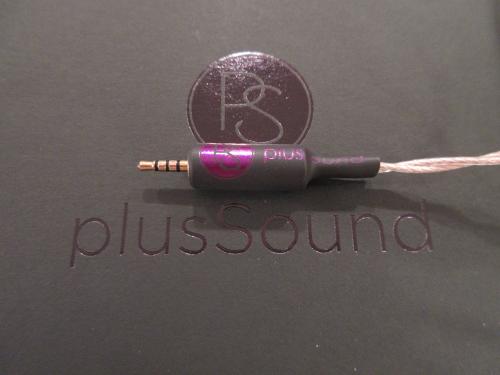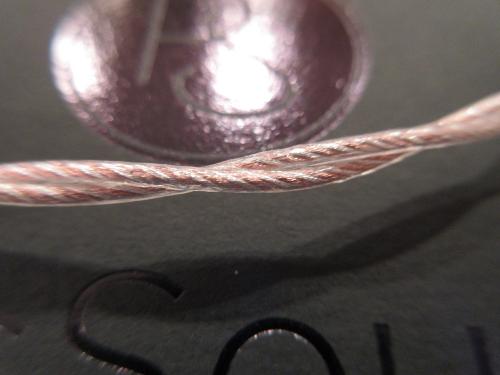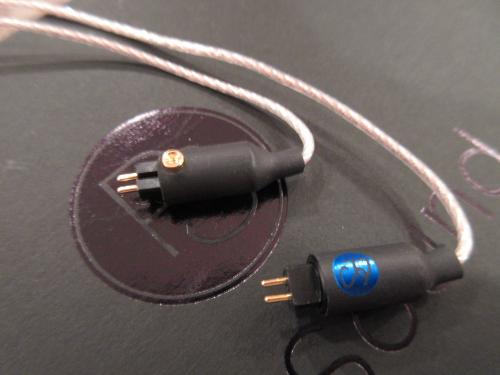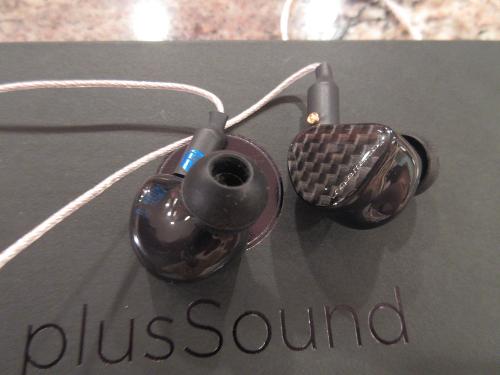PlusSound X-Series GPC
Disclaimer
I would like to thank PlusSound for providing me with the X-Series cable in exchange for my honest opinion. No incentive was given for a favourable review.
X-Series Gold Plated Copper
Links:
http://www.plussoundaudio.com
https://www.facebook.com/plussound/
Preamble
By now I think that it is no secret that I enjoy tinkering around with different cables to see what, if anything, it does with the sound of my IEMs. Like a good little audiophile (read: hopeless addict) I tend to gravitate towards the more "up market" cables (read: Oh my God, it is so expensive!). My personal best achievement in this is wrestling with an insane $2,500 12-wire cable with the ergonomics of a garden hose. Needless to say that during this particular adventure I met my match and had to concede that perhaps I should take a small step back and make more sensible decisions in my life... Well, as sensible as I can be. Don't expect me to be buying a minivan or wearing a tie anytime soon. But the adventure did drive home the point that ergonomics are important to me. Especially when I travel or commute I tend to select gear based on how discrete it is to use and how easily I can store it away in a pocket or backpack. Even though I have a number of very ergonomic 4-wire cables, I still find myself using the tiny Final E2000 for commuting because they store away so much easier, even if it comes at the cost of sound quality. But then I would be sitting on the bus thinking... "Do I dare show myself in public like this?" "What if someone from Head-fi sees me??" "What if they make pictures?!?" Obviously a solution had to be found, but what would be the ideal solution? Among a number of thin, ergonomic cables, the PlusSound X-Series has attracted my attention the most often. No doubt because I am familiar with PlusSound's very ergonomic 4-wire Exo cables and I always wondered how good the 2-wire X-Series would be. Needless to say that when the opportunity presented itself to review one, I leaped at the opportunity to see if I could put it to the test and (hopefully) save my audiophile dignity on my next commute.
Unboxing
The X-Series cable came in the familiar satin black box with black sleeve around it that, apart from the nice glossy black artwork, contained information on the back about the cable, instructions on how to use and care for it and warranty details. Inside the box was of course the cable that was sealed in a clear bag (which I removed before taking the pictures because I was far too eager to have a quick listen first) and alongside a small box with accessories. The accessories are an amplifier band, a microfiber cloth, a cleaning tool and a leather strap to help organise the cable. I have addressed these in more detail when they were first released and I still think it is a very useful set of accessories, as well as a very convenient box.


Of course ultimately it is all about the cable and it looks gorgeous. In fact, I think this is one of the most beautiful cables I have reviewed so far. The new parts that I will discuss in more detail later, add a lovely bit of colour and for this cable the colour combination works especially well. The 2-pin connectors and 3.5mm termination are all black and finished with a gold cap, the y-split is also gold coloured aluminium with a black slider and those gold accents match the colour of the cable really well.

Build quality and ergonomics
Before this review I already had the opportunity to have a closer look at two other PlusSound cables, the Exo Silver+Gold and the X6 Tri-Copper, and I absolutely loved the build quality of those cables. The parts that PlusSound used were very solid and felt like they were built to last. Indeed, I used the rather silly term "utilistic" to describe the design, referring to the feel of the parts that gave me the impression of being purposely designed to be used and used extensively. The connectors and termination were quite chunky with a heat shrink cover that gave a solid feel to the parts when plugging and unplugging, and it made the cables a pathological cable-roller's dream. Since I can't ever just settle on one cable paired with my IEMs that would be me, and I greatly appreciated it.
For 2019 though PlusSound developed new parts to replace their trademark heat shrink, a somewhat risky move considering it was very much a part of what distinguished PlusSound cables. But as soon as I saw and started using the new parts, I realised that it was very much an evolution of the design. On the connectors and termination the heat shrink is now replaced by a cover that feels just as solid, but is a little thinner and has a coloured cap that works as a left and right indicator (although they can also be the same colour). For the termination there are four colour options, black, gold, silver and rose gold, while for the connectors there are two additional options with red and blue (often used to indicate the right and left sides respectively). The feel of the new cover is very similar to the heat shrink and it is still a dream to use when switching between cables.


The ergonomics while wearing the X-Series are fantastic and the cable generally just disappears completely. I did find that for some reason the cable is a little more prone to tangling and that can be a bit fiddly at times when removing it from a pocket in order to use it. However, I often just run the cable under a shirt when I am commuting to avoid it getting in the way or catching behind something when I move around and then I am completely unaware of the cable, it is that thin and ergonomic. Indeed, my commuting setup now consists of the Shanling M0 paired with the Custom Art FIBAE Black and of course the X-Series GPC. It is a great sounding and extremely musical setup, perfect for listening to some fun tunes while doing a dreary commute. Love it!
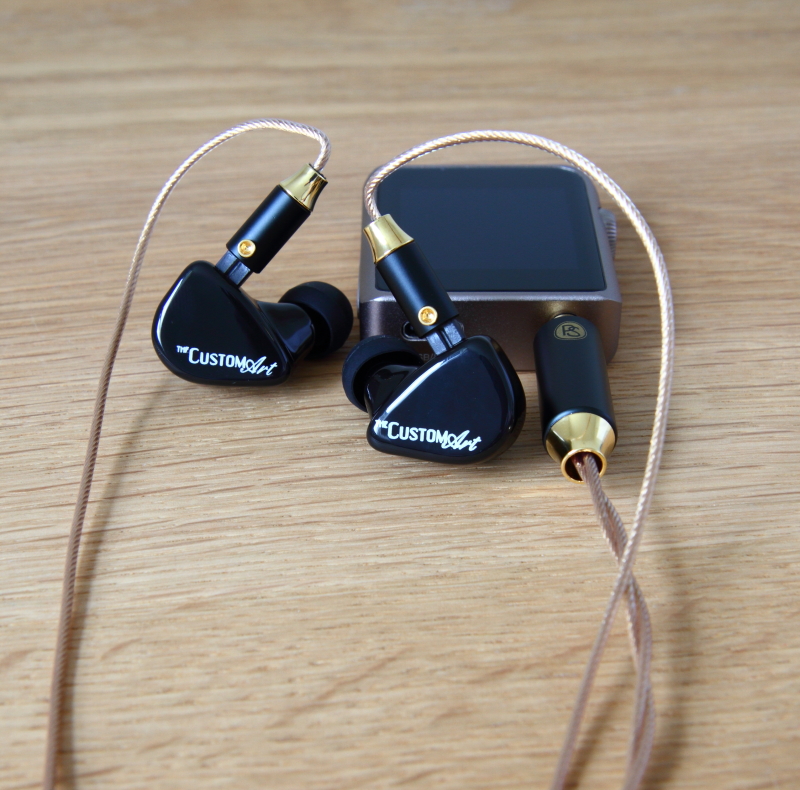
Source and IEMs
All listening was done with the Cowon Plenue 2, a neutral DAP, from the SE out. As synergy is very important with cable pairings, I tried a number of different IEMs. Because of the excellent synergy, the main impressions I give here were made with the Custom Art FIBAE Black and I will give more succinct impressions of additional pairings further down.
Presentation
Every cable has general characteristics that might or might not work well with certain IEMs and I enjoy trying to find great synergy, because if the cable does pair well with IEMs the result can be incredibly good. So too with the pairing of the X-Series GPC with the Custom Art FIBAE Black. The X-Series GPC seems to take all the best bits of the Black and take it up a notch. The Black are very musical and dynamic with the stock cable and the X-Series GPC takes that to the next level and really emphasises the musicality of the Black. The pairing is so good that I consider it the most musical and engaging pairing I have around.
The X-Series GPC is a slightly warm and very natural sounding cable that increases the size of the stage (despite being only a 2-wire cable) and adds a nice amount of air. The image feels cleaner and more stable, which gives a greater sense of clarity. The overall transparency is improved and it makes instruments, vocals and even other sounds come alive even more than with the stock cable. Reverb is a great example here and I was very impressed by how well I could hear it when listening to Elin Manahan-Thomas sing Hildegard of Bingen. The music of this 12th century Benedictine abbess comes through so well with this pairing as the solo vocals bounce off the walls of the church where the recording was made, giving that feel to the music that only a church can give. In the same way my recording of Bach's Magnificat feels so much grander with this pairing because of how tangible the environment feels. This effect is something I put down to how well the X-Series GPC accentuates those specific strengths of the Black. It does not just work with classical music, but any music really. Everything I listen to sounds more dynamic and more realistic, like hearing it performed live.
Bass
That feeling of the music being performed live comes in no insignificant part from the bass that extends a little deeper and takes on a more analogue quality, although without losing the inherent speed of the Black's bass. The Black have a quick and agile bass that punches quite hard and precise, which is just as fast with the X-Series GPC, but punches even harder. When listening to the Foo Fighters' Cheer Up Boys (Your Make Up Is Running) the opening drums hit harder and just as fast, sometimes waking me up if I happen to have dozed off a bit while working behind my computer. The punches instantly get me engaged and although it might not have the effect of making me work harder, it does have the effect of making me dance while seated in my desk chair, which I think makes for quite an entertaining sight. That analogue quality also works great with the Rolling Stones and the kick drum in Hate To See You Go sounds just awesome, giving a bit of a dynamic driver quality to the bass of the Black's single BA driver.
Mids
The mids of the Black are quite natural to begin with and the X-Series GPC compliments that too. The mids become cleaner and more airy, while the tonality feels a bit more accurate with improved transparency to give instruments a more realistic texture. I love listening to Agnes Obel with this pairing, as the piano sounds gorgeous with a delicate feel to the notes that are accompanied by the slightly cleaner and stronger vocals of Agnes herself. Vocals indeed are a treat with the Black, and the X-Series GPC only further emphasises that for both male and female vocals. With choral pieces such as the previously mentioned Bach's Magnificat, this leads to better layering as an increasing number of voices come in and gives a more dynamic feel to the way the music builds up in scale. Female vocals have a crisp clarity to them, but with a hint of sweetness to make the soprano voices a little easier on the ears, and male vocals have that deep natural throatiness to them. Again, these are strengths that the Black already have, but that the X-Series GPC accentuates very nicely.
Treble
Like the bass, the treble gets extended a little further to add a bit more air to the stage and a nice, but still very natural sparkle. The difference is not huge and I really appreciate that because the Black have a very nice laid-back sound that I would not want to tinker around with too much. Still, cymbals get a little more sparkle without being pushed further forward.
One of the things I generally attribute to the treble is the bite in strings. Be it violin or guitar, if the treble is attenuated too much then the strings will lose some bite and crunch. With the X-Series GPC the Black give one of the best bits of crunch to guitar strings I have heard and it is one of the key factors in how engaging the Black are. I absolutely love it and it is pure pleasure to listen to the Stones or Santana with this pairing.

Pairings
-Empire Ears Phantom-
The difference between the Phantom's stock Ares II and the X-Series GPC is very small and that is actually quite impressive seeing how the Ares II is a high quality 4-wire cable compared to the X-Series 2-wire configuration. The sound with the X-Series GPC is slightly cleaner due to a tighter bass and brighter treble, but that difference is very small indeed. Transparency seems to be touch better and the stage dimensions are very similar. I had expected a clearer difference, but this pairing shows that the X-Series makes for a great ergonomic alternative to the stock 4-wire cable.
-64 Audio Tia Trio-
This pairing is more clearly different and very much in line with the synergy between the X-Series GPC and the Black, the Trio really seem to work well with this cable. The sound become more punchy, the bass extends deeper and the treble is more sparkly, while the overall feel is cleaner and a hint more transparent. The musicality of the Trio is kicked up a notch and I really enjoy this pairing. It is exciting and musical with the great technicality of the Trio, making them very engaging and I love the deep bass this pairing is capable of.
-64 Audio U12t (M20)-
This is an outstanding pairing in my opinion and I really love it. The X-Series GPC adds a more full bodied bass to the U12t and warms up the signature slightly to become, in my opinion (based on my preferences) a bit more natural sounding. The U12t become more musical, rather than technical in their sound and the balance in the overall signature is more to my liking. It sounds like how I always imagined U12t could sound before hearing them, which is purely based on my preferences for a slightly warm, musical signature with outstanding bass.
Conclusions
The PlusSound X-Series Gold Plated Copper is a wonderfully ergonomic cable with great performance and has quickly become one of my favourite pieces of gear. It seems to pair well with different types of IEMs and even though it is only a 2-wire configuration, performs easily as well as premium 4-wire cables. Build quality with the new parts that PlusSound introduced this year is excellent and makes for a great option for those looking for a highly customisable and durable replacement for their stock cable.
Disclaimer
I would like to thank PlusSound for providing me with the X-Series cable in exchange for my honest opinion. No incentive was given for a favourable review.
X-Series Gold Plated Copper
- 2-wire cable
- Material: Gold Plated Copper Type 6 Litz
- Gauge: 26AWG
- Cores: 7
- Insulation: PS
- Cryogenically Treated
- Price: US$349.99
Links:
http://www.plussoundaudio.com
https://www.facebook.com/plussound/
Preamble
By now I think that it is no secret that I enjoy tinkering around with different cables to see what, if anything, it does with the sound of my IEMs. Like a good little audiophile (read: hopeless addict) I tend to gravitate towards the more "up market" cables (read: Oh my God, it is so expensive!). My personal best achievement in this is wrestling with an insane $2,500 12-wire cable with the ergonomics of a garden hose. Needless to say that during this particular adventure I met my match and had to concede that perhaps I should take a small step back and make more sensible decisions in my life... Well, as sensible as I can be. Don't expect me to be buying a minivan or wearing a tie anytime soon. But the adventure did drive home the point that ergonomics are important to me. Especially when I travel or commute I tend to select gear based on how discrete it is to use and how easily I can store it away in a pocket or backpack. Even though I have a number of very ergonomic 4-wire cables, I still find myself using the tiny Final E2000 for commuting because they store away so much easier, even if it comes at the cost of sound quality. But then I would be sitting on the bus thinking... "Do I dare show myself in public like this?" "What if someone from Head-fi sees me??" "What if they make pictures?!?" Obviously a solution had to be found, but what would be the ideal solution? Among a number of thin, ergonomic cables, the PlusSound X-Series has attracted my attention the most often. No doubt because I am familiar with PlusSound's very ergonomic 4-wire Exo cables and I always wondered how good the 2-wire X-Series would be. Needless to say that when the opportunity presented itself to review one, I leaped at the opportunity to see if I could put it to the test and (hopefully) save my audiophile dignity on my next commute.
Unboxing
The X-Series cable came in the familiar satin black box with black sleeve around it that, apart from the nice glossy black artwork, contained information on the back about the cable, instructions on how to use and care for it and warranty details. Inside the box was of course the cable that was sealed in a clear bag (which I removed before taking the pictures because I was far too eager to have a quick listen first) and alongside a small box with accessories. The accessories are an amplifier band, a microfiber cloth, a cleaning tool and a leather strap to help organise the cable. I have addressed these in more detail when they were first released and I still think it is a very useful set of accessories, as well as a very convenient box.


Of course ultimately it is all about the cable and it looks gorgeous. In fact, I think this is one of the most beautiful cables I have reviewed so far. The new parts that I will discuss in more detail later, add a lovely bit of colour and for this cable the colour combination works especially well. The 2-pin connectors and 3.5mm termination are all black and finished with a gold cap, the y-split is also gold coloured aluminium with a black slider and those gold accents match the colour of the cable really well.

Build quality and ergonomics
Before this review I already had the opportunity to have a closer look at two other PlusSound cables, the Exo Silver+Gold and the X6 Tri-Copper, and I absolutely loved the build quality of those cables. The parts that PlusSound used were very solid and felt like they were built to last. Indeed, I used the rather silly term "utilistic" to describe the design, referring to the feel of the parts that gave me the impression of being purposely designed to be used and used extensively. The connectors and termination were quite chunky with a heat shrink cover that gave a solid feel to the parts when plugging and unplugging, and it made the cables a pathological cable-roller's dream. Since I can't ever just settle on one cable paired with my IEMs that would be me, and I greatly appreciated it.
For 2019 though PlusSound developed new parts to replace their trademark heat shrink, a somewhat risky move considering it was very much a part of what distinguished PlusSound cables. But as soon as I saw and started using the new parts, I realised that it was very much an evolution of the design. On the connectors and termination the heat shrink is now replaced by a cover that feels just as solid, but is a little thinner and has a coloured cap that works as a left and right indicator (although they can also be the same colour). For the termination there are four colour options, black, gold, silver and rose gold, while for the connectors there are two additional options with red and blue (often used to indicate the right and left sides respectively). The feel of the new cover is very similar to the heat shrink and it is still a dream to use when switching between cables.


The ergonomics while wearing the X-Series are fantastic and the cable generally just disappears completely. I did find that for some reason the cable is a little more prone to tangling and that can be a bit fiddly at times when removing it from a pocket in order to use it. However, I often just run the cable under a shirt when I am commuting to avoid it getting in the way or catching behind something when I move around and then I am completely unaware of the cable, it is that thin and ergonomic. Indeed, my commuting setup now consists of the Shanling M0 paired with the Custom Art FIBAE Black and of course the X-Series GPC. It is a great sounding and extremely musical setup, perfect for listening to some fun tunes while doing a dreary commute. Love it!

Source and IEMs
All listening was done with the Cowon Plenue 2, a neutral DAP, from the SE out. As synergy is very important with cable pairings, I tried a number of different IEMs. Because of the excellent synergy, the main impressions I give here were made with the Custom Art FIBAE Black and I will give more succinct impressions of additional pairings further down.
Presentation
Every cable has general characteristics that might or might not work well with certain IEMs and I enjoy trying to find great synergy, because if the cable does pair well with IEMs the result can be incredibly good. So too with the pairing of the X-Series GPC with the Custom Art FIBAE Black. The X-Series GPC seems to take all the best bits of the Black and take it up a notch. The Black are very musical and dynamic with the stock cable and the X-Series GPC takes that to the next level and really emphasises the musicality of the Black. The pairing is so good that I consider it the most musical and engaging pairing I have around.
The X-Series GPC is a slightly warm and very natural sounding cable that increases the size of the stage (despite being only a 2-wire cable) and adds a nice amount of air. The image feels cleaner and more stable, which gives a greater sense of clarity. The overall transparency is improved and it makes instruments, vocals and even other sounds come alive even more than with the stock cable. Reverb is a great example here and I was very impressed by how well I could hear it when listening to Elin Manahan-Thomas sing Hildegard of Bingen. The music of this 12th century Benedictine abbess comes through so well with this pairing as the solo vocals bounce off the walls of the church where the recording was made, giving that feel to the music that only a church can give. In the same way my recording of Bach's Magnificat feels so much grander with this pairing because of how tangible the environment feels. This effect is something I put down to how well the X-Series GPC accentuates those specific strengths of the Black. It does not just work with classical music, but any music really. Everything I listen to sounds more dynamic and more realistic, like hearing it performed live.
Bass
That feeling of the music being performed live comes in no insignificant part from the bass that extends a little deeper and takes on a more analogue quality, although without losing the inherent speed of the Black's bass. The Black have a quick and agile bass that punches quite hard and precise, which is just as fast with the X-Series GPC, but punches even harder. When listening to the Foo Fighters' Cheer Up Boys (Your Make Up Is Running) the opening drums hit harder and just as fast, sometimes waking me up if I happen to have dozed off a bit while working behind my computer. The punches instantly get me engaged and although it might not have the effect of making me work harder, it does have the effect of making me dance while seated in my desk chair, which I think makes for quite an entertaining sight. That analogue quality also works great with the Rolling Stones and the kick drum in Hate To See You Go sounds just awesome, giving a bit of a dynamic driver quality to the bass of the Black's single BA driver.
Mids
The mids of the Black are quite natural to begin with and the X-Series GPC compliments that too. The mids become cleaner and more airy, while the tonality feels a bit more accurate with improved transparency to give instruments a more realistic texture. I love listening to Agnes Obel with this pairing, as the piano sounds gorgeous with a delicate feel to the notes that are accompanied by the slightly cleaner and stronger vocals of Agnes herself. Vocals indeed are a treat with the Black, and the X-Series GPC only further emphasises that for both male and female vocals. With choral pieces such as the previously mentioned Bach's Magnificat, this leads to better layering as an increasing number of voices come in and gives a more dynamic feel to the way the music builds up in scale. Female vocals have a crisp clarity to them, but with a hint of sweetness to make the soprano voices a little easier on the ears, and male vocals have that deep natural throatiness to them. Again, these are strengths that the Black already have, but that the X-Series GPC accentuates very nicely.
Treble
Like the bass, the treble gets extended a little further to add a bit more air to the stage and a nice, but still very natural sparkle. The difference is not huge and I really appreciate that because the Black have a very nice laid-back sound that I would not want to tinker around with too much. Still, cymbals get a little more sparkle without being pushed further forward.
One of the things I generally attribute to the treble is the bite in strings. Be it violin or guitar, if the treble is attenuated too much then the strings will lose some bite and crunch. With the X-Series GPC the Black give one of the best bits of crunch to guitar strings I have heard and it is one of the key factors in how engaging the Black are. I absolutely love it and it is pure pleasure to listen to the Stones or Santana with this pairing.

Pairings
-Empire Ears Phantom-
The difference between the Phantom's stock Ares II and the X-Series GPC is very small and that is actually quite impressive seeing how the Ares II is a high quality 4-wire cable compared to the X-Series 2-wire configuration. The sound with the X-Series GPC is slightly cleaner due to a tighter bass and brighter treble, but that difference is very small indeed. Transparency seems to be touch better and the stage dimensions are very similar. I had expected a clearer difference, but this pairing shows that the X-Series makes for a great ergonomic alternative to the stock 4-wire cable.
-64 Audio Tia Trio-
This pairing is more clearly different and very much in line with the synergy between the X-Series GPC and the Black, the Trio really seem to work well with this cable. The sound become more punchy, the bass extends deeper and the treble is more sparkly, while the overall feel is cleaner and a hint more transparent. The musicality of the Trio is kicked up a notch and I really enjoy this pairing. It is exciting and musical with the great technicality of the Trio, making them very engaging and I love the deep bass this pairing is capable of.
-64 Audio U12t (M20)-
This is an outstanding pairing in my opinion and I really love it. The X-Series GPC adds a more full bodied bass to the U12t and warms up the signature slightly to become, in my opinion (based on my preferences) a bit more natural sounding. The U12t become more musical, rather than technical in their sound and the balance in the overall signature is more to my liking. It sounds like how I always imagined U12t could sound before hearing them, which is purely based on my preferences for a slightly warm, musical signature with outstanding bass.
Conclusions
The PlusSound X-Series Gold Plated Copper is a wonderfully ergonomic cable with great performance and has quickly become one of my favourite pieces of gear. It seems to pair well with different types of IEMs and even though it is only a 2-wire configuration, performs easily as well as premium 4-wire cables. Build quality with the new parts that PlusSound introduced this year is excellent and makes for a great option for those looking for a highly customisable and durable replacement for their stock cable.







